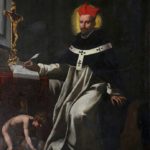Blessed John Dominici (Bishop)
Bl. John Dominici (Giovanni Dominici) was born into poverty in Florence around the year 1356. His childhood was marked by piety and devotion, and he could almost always be found praying in the Dominican church of Santa Maria Novella. When he was 15 years old, he attempted to join the Order of Preachers—or Dominicans, as […]



Bl. John Dominici (Giovanni Dominici) was born into poverty in Florence around the year 1356. His childhood was marked by piety and devotion, and he could almost always be found praying in the Dominican church of Santa Maria Novella. When he was 15 years old, he attempted to join the Order of Preachers—or Dominicans, as they are more popularly known—but was originally rejected because of his lack of education and a severe speech impediment which would have made it impossible for him to carry out his vocation as a preacher. But by the time he was 17, the fathers relented and he was allowed to begin his novitiate. Found to be a superior student, John was sent to Paris to finish his studies in theology and Sacred Scripture.
The problem of his speech impediment was still an issue, however, and his superiors attempted to spare John embarrassment by assigning him to duties in the convent. John turned to prayer, invoking the intercession of St. Catherine of Siena who had just died, and he asked for a cure. Miraculously, the impediment disappeared, and John was thus able to begin preaching, eventually becoming one of the most famous of Dominican preachers.
John preached and taught throughout Italy for 12 years, then became prior of Santa Maria Novella where his vocation had begun. During this time, the plague known as the Black Death struck: Santa Maria Novella lost 77 friars within a few months; other convents fared even worse — the mortality rate being so high among the friars because of their unselfish aid to the sick and the dying. Because of the decimation of the order, many Dominicans felt the times called for a relaxing of the rule, and several houses began to operate accordingly. With permission of the master general of the order, Blessed Raymond of Capua, John took upon himself the task of correcting this laxity and bringing the Order of Preachers back to its first fervor.
He began his work with a foundation at Fiesole; among his first novices were young Antoninus of Florence (see May 10) as well as two brothers, gifted artists who became known as Fra Angelico and Fra Benedetto. Soon the house at Fiesole, and others modeled upon it, could be described as the first houses of the order were: “Homes of Angels.”
Pope Gregory XII made John his counselor and in 1408 named him archbishop of Ragusa and later cardinal of San Sisto. John was one of those who convinced Gregory to resign the papacy in order to end the Western Schism, and so the groundwork was laid for the election of a new and acceptable candidate, Pope Martin V. John himself resigned his cardinalate to clear himself of accusations that his actions were motivated by political ambition.
Martin V appointed John legate to Bohemia and Hungary to combat the heresies of the Hussites, but John died from a fever on June 10, 1419, soon after his arrival in Hungary. He was buried in the Church of Saint Paul the Hermit in Buda. Many miracles were worked at his tomb before it was destroyed by the Turks.
Lessons
1. John Dominici felt called to join the Order of Preachers, and he pursued his calling despite the seeming impossibility of his situation: his severe speech impediment and his lack of education. His persistence and trust in God — and in the intercession of the saints — should inspire any of us facing difficulties, physical or otherwise, to always keep our confidence in God, for whom all things are possible.
2. John played an important part as a healer of the great division in the Church known as the Western Schism. Let us all follow his example and create unity wherever we find divisiveness, for, as our Lord has said, “If a house is divided against itself, that house can never stand” (Mark 3:25).
Other Saints We Remember Today
- St. Margaret of Scotland (1093), Queen
- St. Landericus (Landry) (661), Bishop of Paris
✠
image: Painting of Bl. Giovanni Dominici by Jacopo Vignali, photo by Sailko / Wikimedia Commons (CC BY 3.0)














